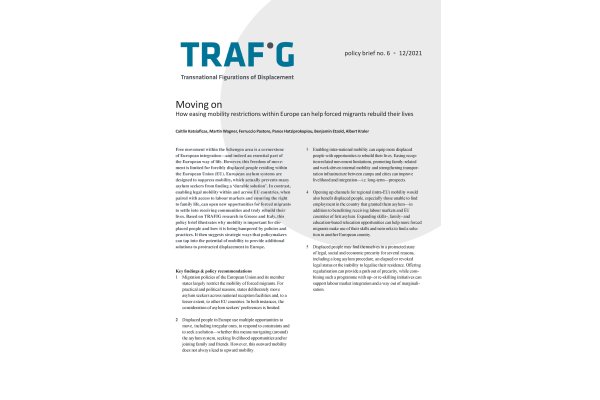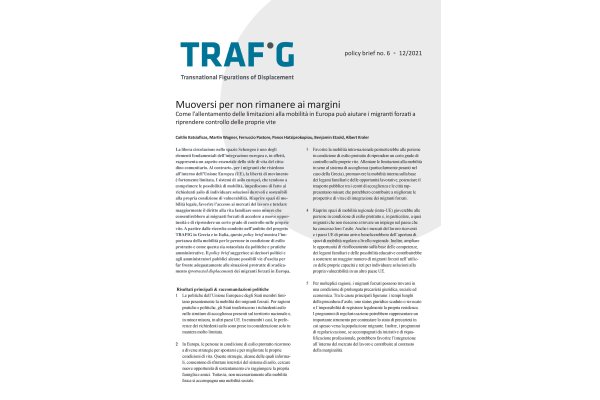TRAFIG policy brief no. 6
Moving on
How easing mobility restrictions within Europe can help forced migrants rebuild their lives
Free movement within the Schengen area is a cornerstone of European integration – and indeed an essential part of the European way of life. However, this freedom of movement is limited for forcibly displaced people residing within the European Union (EU). European asylum systems are designed to suppress mobility, which actually prevents many asylum seekers from finding a ‘durable solution’. In contrast, enabling legal mobility within and across EU countries, when paired with access to labour markets and ensuring the right to family life, can open new opportunities for forced migrants to settle into receiving communities and truly rebuild their lives. Based on TRAFIG research in Greece and Italy (which is presented in TRAFIG working paper no. 9), this policy brief illustrates why mobility is important for displaced people and how it is being hampered by policies and practices. It then suggests strategic ways that policymakers can tap into the potential of mobility to provide additional solutions to protracted displacement in Europe.
Key findings & policy recommendations:
- Migration policies of the EU and its Member States largely restrict the mobility of forced migrants. For practical and political reasons, states do deliberately move asylum seekers across national reception facilities and, to a lesser extent, to other EU countries. In both instances, the consideration of asylum seekers’ preferences is limited.
- Displaced people in Europe use multiple opportunities to move, including irregular ones, to respond to constraints and to seek a solution – whether this means navigating (around) the asylum system, seeking livelihood opportunities and/or joining family and friends. However, this outward mobility does not always lead to upward mobility.
- Enabling intra-national mobility can equip more displaced people with opportunities to rebuild their lives. Easing reception-related movement limitations, promoting family-related and work-driven internal mobility and strengthening transportation infrastructure between camps and cities can improve livelihood and integration – i.e. long-term – prospects.
- Opening up channels for regional (intra-EU) mobility would also benefit displaced people, especially those unable to find employment in the country that granted them asylum – in addition to benefitting receiving labour markets and countries of first asylum. Expanding skills-, family- and education-based relocation opportunities can help more forced migrants make use of their skills and networks to find a solution in another European country.
- Displaced people may find themselves in a protracted state of legal, social and economic precarity for several reasons, including a long asylum procedure, an elapsed or revoked legal status or the inability to legalise their residence. Offering regularisation can provide a path out of precarity, while combining such a programme with up- or re-skilling initiatives can support labour market integration and a way out of marginalisation.
.png) Multiple mobilities of Greece and Italy arrivals / © ICMPD, Nikolina Sladojevi
Multiple mobilities of Greece and Italy arrivals / © ICMPD, Nikolina Sladojevi
Authors: Caitlin Katsiaficas, Martin Wagner, Ferruccio Pastore, Panos Hatziprokopiou, Benjamin Etzold, Albert Kraler
**You can download TRAFIG policy brief no. 6 in
Cite as: Katsiaficas, C. et al. (2021). Moving on. How easing mobility restrictions within Europe can help forced migrants rebuild their lives (TRAFIG policy brief 6): Bonn: BICC. DOI: 10.5281/zenodo.5845992
Cite as: Katsiaficas, C. et al. (2021). Muoversi per non rimanere ai margini. Come l’allentamento delle limitazioni alla mobilità in Europa può aiutare i migranti forzati a riprendere controllo delle proprie vite (TRAFIG policy brief 6): Bonn: BICC. DOI: 10.5281/zenodo.5997191

